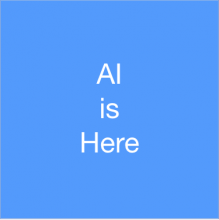Created: November 2017. Last Updated: March 2018
Learning Goal
Understand what AI-based technologies are, and some of their basic characteristics.
Estimated Time
50 minutes
[25 minutes] Activity #1
[25 minutes] Assignment
Materials
Paper
Pen or pencil
[Optional] Computer or mobile device
Resources
Article: What Artificial Intelligence Can and Can’t Do Right Now - by Andrew Ng (Harvard Business Review)
Video: What Is Artificial Intelligence (Or Machine Learning)? - by HubSpot
Activity #1: Demystifying AI
We’ve seen examples of Artificial Intelligence (AI) in popular movies such as The Terminator and Blade Runner. And you’ve probably seen news about things like self-driving cars and Google’s AlphaGo. You might be wondering, how can something like a virtual chatbot that answers your questions while you’re shopping online be compared to an autonomous vehicle? AI spans a huge range of topics and technologies and can have many different applications.
Some approaches to AI aim to get a computer to do tasks in the same way that a human would. Other approaches focus more on getting a computer to do the same tasks as a human but in a different manner. Lastly, an AI algorithm might be designed to accomplish a task that is difficult or impossible for a human to complete, such as translating a foreign language in real time.
AI-based technologies can learn, solve problems, process data (big and small amounts), and take actions to achieve a specific goal. Because these technologies mimic the functions that the human mind performs, they have been conceptualized as “artificial intelligence.”
A Brief History of Artificial Intelligence
During the first stages of artificial intelligence research in the second half of the 20th century, scientists emphasized techniques based on human-provided rules. These rules were usually in the form of conditional statements, or statements that include words like “if” and “then.” A data scientist using a conditional statement might, for example, create the following rule: “if the stock price is above $1,000, then sell it.” These techniques are referred to as search, “rule-based” or “expert-knowledge systems.”
Figure 1) A photo of computer code on a screen
In recent years, there has been a focus on big data and machine learning. Machine learning allows computers to make predictions and do things they weren’t explicitly programmed to do. An important difference between this technique and earlier rule-based systems is that machine learning algorithms detect patterns and develop rules on their own. Machine learning is just one of several subfields of artificial intelligence.
Advances in both computer software and hardware, such as cheaper sensors, decreased costs of cloud storage, and faster broadband connection, have played a role in bringing big data to the forefront of computer science. With major increases in computational power and ability, companies and researchers using AI-based technologies can collect, store, and analyze massive amounts of data.
Current State of Artificial Intelligence Technology
AI-based technologies powered by machine learning are often quite good at perceptual tasks such as image recognition, but they are nowhere near perfect. The image below illustrates how an image recognition deep neural network can interpret white noise static and otherwise abstract images as concrete objects like comic books and cheetahs.
Figure 2) Images labeled with captions given to them by an image recognition neural net
While these mistakes are interesting to point out, the stakes get higher when companies attempt to use AI in social and public spaces. Indeed, flawed AI algorithms can cause serious problems when they become a part of people’s lives. For example, Google’s attempts to identify people in photos could not identify people of color, instead categorizing people with darker skin tones as animals. This was likely because software developers only used pictures of light-skinned individuals for training the AI algorithms. In some cases, such as Google’s image recognition problem, these limitations could be overcome by training the algorithms with better, more representative and diverse data sets. However, it’s important to note that it is not always possible to easily identify and correct the error that caused an inappropriate and incorrect output.
Assignment
Our everyday lives are increasingly surrounded by AI-driven technologies. Which AI-based technology do you think you use most frequently in your daily life? What are the "intelligent" characteristics of this technology? What problems can this AI system solve? What are the autonomous actions it can take? In a paragraph or two (written or typed), explore these questions.
Example:
I use Google Maps every day to find the shortest route to the places where I have to go. This technology is intelligent because it can find the shortest path between two points on the map, and gives me directions on how to navigate to the place I want to go. Autonomously, Google Maps can solve the problem of finding the shortest route after evaluating many options very quickly. This tool can also autonomously update my position on the map, providing me with specific directions depending upon my location.
Figure 3) A photo of two toy robots dancing

